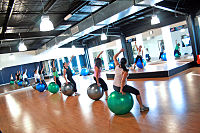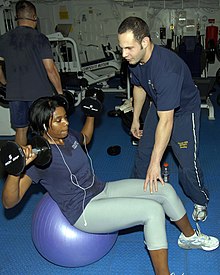

An exercise ball is a ball constructed of soft elastic, typically in 5 diameters of 10 cm increments, from 35 to 85 cm (14 to 33 in), and filled with air. The air pressure is changed by removing a valve stem and either filling with air or letting the ball deflate. It is most often used in physical therapy, athletic training and exercise. It can also be used for weight training.
The ball is also known by various other names, for instance: balance ball, birth ball, body ball, fitness ball, gym ball, gymnastic ball, physio ball, pilates ball, Pezzi ball, stability ball, Swedish ball, Swiss ball, therapy ball, or yoga ball.
History
The physical object known as a "Swiss Ball" was developed in 1963 by Aquilino Cosani, an Italian plastics manufacturer. He developed a process for moulding large puncture-resistant plastic balls. According to American physical therapist Joanne Posner-Mayer, the use of the exercise ball as a therapy tool probably begins with the Swiss pediatrician Dr. Elsbeth Köngan, an early advocate of the Bobath concept. Those balls, then known as "Pezzi balls", were first used in treatment programs for newborns and infants by Mary Quinton, a British physiotherapist working in Switzerland.
Later, Dr. Susanne Klein-Vogelbach, the director at the Physical Therapy School in Basel, Switzerland, integrated the use of ball exercise as physical therapy for neuro-developmental treatment. In 1985, she published a famous book “Ballgymnastik zur funktionellen Bewegungslehre” (“Ball Gymnastics for functional movement theory”), where she described several exercises with the ball. Klein-Vogelbach advocated the use of ball techniques to treat adults with orthopedic or medical problems.
In 1995, Joanne Posner-Mayer published a book "Swiss Ball Applications for Orthopedic and Sports Medicine" in the US. As American physical therapists began to use ball exercises, the term became common in the US. From their development as physical therapy in a clinical setting, those exercises are now used in athletic training, as part of a general fitness routine and incorporation in alternative exercises such as yoga and Pilates.
The fastest time to jump across 10 swiss balls is 7.8 seconds and was achieved by Neil Whyte (Australia) on the set of CCTV - Guinness World Records Special in Beijing, China on 12 January 2016.The most push-ups performed on 4 swiss balls in one minute is 31 and was achieved by Neil Whyte (Australia) on the set of CCTV Guinness World Records Special in Beijing, China, on 17 August 2011. Neil also made the record for the farthest jump between two Swiss balls at a distance of 2.3 meters in 2006.
Benefits

A primary benefit of exercising with an exercise ball as opposed to exercising directly on a hard flat surface is that the body responds to the instability of the ball to remain balanced, engaging many more muscles (so-called “unstable training”). Those muscles become stronger over time to keep balance. Some dumbbell exercises, such as dumbbell fly can be performed on a ball. Ball exercises are popular among runners.
Most frequently, the core body muscles; the abdominal muscles and back muscles are the focus of exercise ball fitness programs.
Using an unstable surface recruits more muscle units without increasing the total load. The greatest benefit of moving an exercise onto an unstable surface is achieving a greater activation of the core musculature, exercises such as curl-up or push-up performed on an exercise ball. An unstable surface increases activation of the rectus abdominis muscles (abdominals) and allows for greater activity per exercise when compared to a stable surface. Exercises such as a curl-up on an exercise ball yields a greater amount of electromyographic (EMG) activity (electrical activity produced by muscles) compared to exercises on a stable platform. Performing standard exercises, such as a push-up, on an unstable surface can be used to increase activation of core trunk stabilizers and in turn provide increased trunk strength and greater resistance to injury.
Other uses
There is no scientific evidence of benefits from sitting on exercise balls without additional exercises.
This large plastic ball, known as a "birth ball", can also be used during labour to aid the descent of the fetal head into the pelvis. Sitting in an upright position will also aid fetal positioning and is more comfortable for the woman. Sitting on the ball with arms placed on a bed, table or otherwise sturdy object for support and gently rocking the hips may help with the contractions and aid the natural physiological process of birth. However, using the ball as an alternative to normal seating (such as in the office) can result in discomfort due to the lack of back support.
Eight exercise balls are used in the game Treibball. In the context of this sport, the balls are referred to as "rolling sheep".
See also
Bibliography
- Klein-Vogelbach, Susanne (1985). Ballgymnastik zur funktionellen Bewegungslehre [Ball gymnastics for functional movement theory]. Rehabilitation und Prävention (in German) (2d ed.). Springer-Verlag Berlin Heidelberg. doi:10.1007/978-3-662-05975-3. ISBN 978-3-540-13925-6.
- Posner-Mayer, Joanne (1995). Swiss Ball Applications for Orthopedic & Sports Medicine: A Guide for Home Exercise Programs Utilizing the Swiss Ball. Ball Dynamics International. ISBN 9780964534148.
References
- ^ Flett, Maureen (2003). Swiss Ball: For Strength, Tone and Posture. Sterling Publishing. p. 6. ISBN 1-85648-663-X – via Internet Archive.
- ^ Craig, Colleen (2001). Pilates on the Ball: The World's Most Popular Workout Using the Exercise Ball. Simon & Schuster. p. 23. ISBN 9781594775932 – via Google Books.
- Carriere, Beate; Renate Tanzberger (1998). The Swiss Ball: Theory, Basic Exercises and Clinical Application. Springer. ISBN 3-540-61144-4.
- Hillman, Susan Kay (2005). Introduction to Athletic Training. Human Kinetics. ISBN 0-7360-5292-5.
- Milligan, James (2005). Swiss Ball For Total Fitness: A Step-by-step Guide. Sterling Publishing Company, Inc. ISBN 1-4027-1965-5.
- Mitchell, Carol (2003). Yoga on the Ball. Inner Traditions / Bear & Company. ISBN 0-89281-999-5.
- Glenday, Craig (2013). Guinness World Records 2014. Guinness World Records Limited. p. 13. ISBN 978-1-908843-15-9.
- Vera-Garcia, FJ; Grenier, SG; McGill, SM (2000). "Abdominal muscle response during curl-ups on both stable and labile surfaces". Physical Therapy. 80 (6): 564–569. doi:10.1093/ptj/80.6.564. PMID 10842409. Archived from the original on September 27, 2007.
- "Gym Ball Exercises That Everyone Should Be Doing". coachmag.co.uk. March 19, 2021. Retrieved April 20, 2021.
- Demoss, Daniel (April 2, 2021). "Dumbbell Chest Exercises You Can Do Without a Bench". dumbbellsreview.com. Retrieved April 20, 2021.
- "Exercise ball home workout for runners". Canadian Running. July 20, 2020. Retrieved April 20, 2021.
- "Fitness ball". Mayo Clinic. April 9, 2019. Retrieved April 20, 2021.
- ^ Clark, K. M.; Holt, L. E.; Sinyard, J. (2003). "Electromyographic comparison of the upper and lower rectus abdominis during abdominal exercises". The Journal of Strength and Conditioning Research. 17 (3): 475–483. doi:10.1519/1533-4287(2003)017<0475:ecotua>2.0.co;2. PMID 12930172. S2CID 23688868.
- Anderson, Gregory S.; Gaetz, Michael; Holzmann, Matt; Twist, Peter (2013). "Comparison of EMG activity during stable and unstable push-up protocols". European Journal of Sport Science. 13 (1): 42–48. doi:10.1080/17461391.2011.577240. S2CID 145637535.
- Gregory DE, Dunk NM, Callaghan JP (2006). "Stability ball versus office chair: comparison of muscle activation and lumbar spine posture during prolonged sitting". Hum Factors. 48 (1): 142–53. doi:10.1518/001872006776412243. PMID 16696264. S2CID 2050099.
- McGill SM, Kavcic NS, Harvey E (May 2006). "Sitting on a chair or an exercise ball: various perspectives to guide decision making". Clin Biomech (Bristol, Avon). 21 (4): 353–60. doi:10.1016/j.clinbiomech.2005.11.006. PMID 16410033.
- Gregory, Diane E. "The Use of Stability Balls in the Workplace in Place of the Standard Office Chair". Centre for Research Expertise for the Prevention of Muscloskeletal Disorders, University of Waterloo. Archived from the original on 31 March 2012. Retrieved 1 January 2011.
- Wessonduring, Nicky (2000). Labor Pain: A Natural Approach to Easing Delivery. Inner Traditions / Bear & Company. ISBN 0-89281-895-6.
- Chang, Elizabeth (September 29, 2020). "You might want to rethink using a stability ball as your desk chair". The Washington Post. Retrieved April 20, 2021.
- Hill, Poppy (2022-08-14). "What is the dog sport Treibball?". Dog Sports Central. Retrieved 2024-08-06.